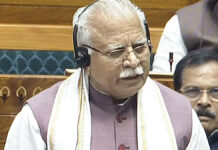If India wants to hold moral high ground along the LAC and counter China, it must aim to be a reliable partner of Tibetans
The recent deployment of the mostly Tibetan Special Frontier Force along the Line of Actual Control (LAC), to counter manoeuvres from China’s People’s Liberation Army (PLA), has renewed attention towards the Free Tibet movement. On most social media platforms and in multiple columns, many commentators had a sudden resurgence of conscience towards the aspirations of the Tibetan community and an equal surge in respect for its place in Indian polity. This was accentuated when news broke out about the death of SFF Company Leader Nyima Tenzin, who stepped on a stray landmine while patrolling the LAC. Images of Tenzin’s body, draped in the Indian and Tibetan flags, only accentuated solidarity with the Tibetan community. Yet for all this show of sentiment, India’s ambivalence towards the Tibetan cause greatly weakens its legitimacy on the issue. Such retrospective reawakening can only be seen as highly superficial.
After its illegal annexation by China in 1950, a series of aggressive and iconoclastic policies executed in Tibet led to the Dalai Lama taking refuge in India in 1959. Ever since, more than one lakh Tibetans have come to call India their home. While the Cultural Revolution in China attempted at eradicating Tibetan identity, India not only became a physical refuge for its people, but a sanctuary for its rich cultural and religious traditions. During a period when the Communist Party imposed assimilation, India allowed for the integration of the Tibetan community into Indian society at large while aiding it in maintaining its distinct identity. The support provided to Tibetan schools, libraries, cultural institutions and many monasteries are examples of this.
On the political front, however, India has vacillated between occasionally lukewarm to outright apathetic. The fact of the matter is that India has never considered the autonomy of Tibet as a significant objective. Its proximity to the Dalai Lama, and to the Central Tibetan Administration (the Tibetan Government in Exile) based out of Dharamshala, is dependent exclusively on its relations with China. This is the harsh truth. The most recent demonstration of this was in 2018. At a time when India was trying its best at mending frayed relations with China, the 60th anniversary celebrations of the arrival of the Dalai Lama in India were rather coldly shifted from Delhi to Dharamshala. An internal memo circulated within the Government prohibited senior functionaries and ministers from attending any of the events. Such unreceptive behaviour is just one example out of many, spanning multiple governments in power, when India postures itself according to what is satisfactory to China with regard to Tibet.
Although realpolitik does have its time and place, it is imperative to give permanent credence to the Tibetan community and its aspirations. While one can debate about the exact legitimacy of Tibet being a separate State (a highly convoluted historical question), what cannot be questioned is the existence of a national identity, which most certainly merits a certain degree of autonomy. India’s support for this notion is integral at a time when China is not only flexing its ambitions across the border but also redoubling its efforts in Tibet. During the 7th Central Symposium on Tibet held on August 29 — the highest working body for Tibet — Chinese President Xi Jinping called for “sinicizing” Tibetan Buddhism and the building of a “new modern socialist” Tibet. He also stated that Tibet must eventually develop into an “impregnable fortress” of stability. Responding to Xi’s remarks, Lobsang Sangay, the president of the Tibetan government-in-exile, said: “China has been quietly militarising the Tibetan plateau for over 60 years under the pretext of development and modernisation. For Tibet, this has only led to an influx of soldiers, Han (Chinese) settlers, and weapons. For its neighbours, this militarisation of the Tibetan plateau has led to a military build-up on its borders, jeopardising the already contentious border regions as evidenced by the recent Galwan incident.”
Keeping in mind the recent events along the LAC and the timing of this symposium, such a policy outline for Tibet must not be seen independently. China’s renewed attempt in crushing any form of Tibetan dissent is complementary to its advances along the Indo-Tibetan border. Combined, these thrusts aim to validate Chinese rule in Tibet and further encroach upon Indian territory. Both efforts have very little legitimacy. China’s control over Tibet is not only highly questionable, the vast number of cultural, socio-political, and humanitarian atrocities it has carried out has made it constitutionally immoral. To counter China, India must not only strengthen its own borders, but also reinvigorate its support for the Dalai Lama and the Central Tibetan Administration.
Historically, Indo-Tibetan relations date back nearly 2,000 years. Deeper ties can be found in religious texts such as the Mahabharata, which mentions the existence of a realm beyond the Himalayas. Buddhism in Tibet originated from India, and places such as the Kailash Parbat and Manasarovar have a mutual place in the national imaginings of India and Tibet. Shared religious traditions, a common heritage and cultures that are heavily intertwined are just some aspects that have led to historically close relations with the two peoples.
The 60-odd years of Chinese imposition pale in comparison to the shared Indo-Tibetan traditions that have lasted through millennia. This relationship only furthers India’s prerogative to aid the Tibetan people in reclaiming their homeland.
The past few months have demonstrated China’s intentions and have rather graphically illustrated its perception of the border issue. In response, India must adopt a two-pronged approach, one that involves the strengthening of its borders for tactical superiority whilst furthering the aspirations of the Tibetan people; those that are represented by the Dalai Lama and the democratically elected Central Tibetan Administration. What exactly this might entail will have to depend on what is conceivable in the present strategic situation, but this posturing has to be for the long haul. If India wants to hold moral high ground along the LAC, it must aim to be a reliable partner to the people of Tibet. And do so not out of geo-political convenience but because it is the right thing to do.



























